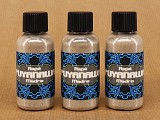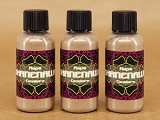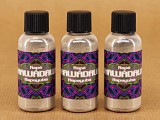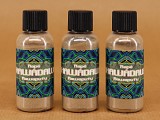Bottle, 10 Ml, 7 Gr from Brazil (SKU 3703)
Restock expected. This sharp yet aromatic Rapé from the Shanenawa tribe combines Moi Tabaco with the sacred ashes of the Caneleiro tree. Though brown in appearance, its effect is bright and high-frequency, closer to a grey Rapé. It enters with a buzzing sting and tear-inducing sharpness, quickly giving way to sweet, rustic, and subtly floral aromas. The Moi Tabaco offers gentle grounding, while the Caneleiro ash brings energetic clarity and a purifying fire. A refined blend for those seeking focus, balance, and spiritual clarity. More information below in the description.
Packed in 10 ml clear plastic bottles containing 7 gr.
| change currency | |||||||||
| SKU | Part | Volume | Weight | Unit | Price | Qty
|
|||
|---|---|---|---|---|---|---|---|---|---|
| 3703 | bottle | 10 ml | 7 gr | 1 pc | $ 21.41 | ||||
| 3706 | bottle | 25 ml | 15 gr | 1 pc | $ 42.83 | ||||
| 3717 | pot | 60 ml | 40 gr | 1 pc | $ 105.80 | ||||
Shanenawa Floresta / Caneleiro. A piercing yet fragrant blend of Moi Tabaco and Caneleiro ashes.
A Dance of Fire and Fragrance
This powerful Rapé from the Shanenawa people of Acre is a masterclass in the balance between intensity and elegance. Though brown in color, its energy is unmistakably that of a grey Rapé: sharp, bright, and cerebrally activating. It enters with a sting—immediate, tear-inducing, almost electric. But within moments, the sharpness dissolves into a bouquet of rustic, sweet, and subtly floral tones. This is a medicine that speaks in contrasts: forceful and refined, disruptive and centering, clearing and calming.
Moi Tabaco – The Gentle Strength Beneath
At the heart of this blend lies Tabaco de Moi, a prized strain of Nicotiana rustica cultivated in the upper Juruá region of Acre. Known for its rich chocolate-like aroma and smooth potency, Moi is twisted into thick ropes and fermented over months, developing a deep, mellow power. It is ideal for blends that emphasize spiritual clarity without overwhelming the body.
Its sweetness and softness offer the perfect base for this sharper, ash-forward blend. Moi doesn’t push—it grounds, holds, and centers. To read a detailed article on the Moi Tabaco and its cultural use, click here.
Caneleiro Ash – The Spirit of Purification
The ashes of the Caneleiro tree (Cenostigma macrophyllum) give this blend its unmistakable bite and brilliance. Used not only by the Shanenawa but also by tribes such as the Huni Kuin, Caneleiro is cherished for its energetic duality. It enters the body like fire—piercing, cleansing, disarming. Then, like cooling earth, it settles into a deep and grounded calm.
This tree is not merely a source of ash—it is a spiritual being, known to burn away confusion, purify emotion, and cut through stagnation. Caneleiro brings a clarity that is felt both mentally and energetically. Click here to explore a full article on Caneleiro ashes and their traditional significance.
The Shanenawa – Voices of the Blue Bird Forest
Known as the “blue bird people,” the Shanenawa live in the Feijó region of Acre and belong to the Pano linguistic family. Their history includes survival through the violence of the rubber boom, resettlement under a misassigned tribal designation, and now, a slow cultural rebirth. Through ceremonies involving Ayahuasca (umi), Kambo, and Rapé, they maintain a living relationship with the forest spirits (jusin), their ancestors, and the sacred plants that guide their way.
Rapé is central to their medicine path—used to open perception, bring focus, and prepare for contact with the unseen. Among all the ashes, Caneleiro is their preferred ally. This blend reflects their unique aesthetic of spirit: strong but clean, fierce yet elegant. To read an in-depth article on the Shanenawa people and their sacred traditions, click here.
A Symphony of Sting, Sweetness, and Stillness
This Rapé carries a sweet and friendly scent—almost deceptive given its sharpness. Upon application, it strikes immediately with a buzzing sting that floods the sinuses and brings tears to the eyes. Yet this intensity fades quickly, revealing an excellent array of aromas: sweet, rustic, spicy, and almost floral. After cleaning the nose, a heightened feeling sets in—marked by greater visual focus, clarity, and energetic elevation.
Though its appearance suggests a semi-brown blend, the sensation it evokes is unmistakably that of a grey Rapé. The energy is light, high-frequency, and not too heavy on the Tabaco. It offers a clear, balanced experience ideal for moments of inner recalibration or ceremonial entry.
Use and Care – Modest Fire, Sacred Ground
Due to its intensity, this Rapé is best used in small quantities. Keep a cloth nearby, as it may prompt purging or tears. Sit upright, breathe (through the mouth) with care, and allow the blend to unfold its gifts. Each preparation is handcrafted and may vary slightly depending on season, tree, and Tabaco batch. As always, approach with respect, and let the medicine teach you its rhythm.
Setting the Standard for Ultra Fine Rapé
We take great care to reprocess all received stock to ensure the finest quality powder. Often, Rapé arrives with varying levels of fineness due to the lack of professional sieves used by the tribe. To address this, we meticulously sieve all powders to remove rough bits and particles, resulting in an exceptionally smooth and effective powder at 150-micron fineness. We use laboratory-grade sieves and dehydrating equipment to achieve this quality. This is our standard because it provides the best Rapé experience.
Disclaimer
The information provided above is for historical, educational, and scientific purposes only. It should not be interpreted as a recommendation for the specific use of our products. Any statements about traditional uses are informational. The use and application of our products are the customer's decision and responsibility.
Copyright Notice
All content, including this article, is protected under copyright law. Any unauthorized reproduction, distribution, or use of this material is prohibited. Duplication of this content, in whole or in part, without written consent, is a violation of copyright regulations.
Other names: Caneleiro
The Shanenawa are a tribe who live in Acre in Brazil in Feijo. They speak Portuguese but the older people and the children tend to speak in their own language Shanenawa. The name ‘Shanenawa’ is composed by the forms shane (blue-coloured bird) and nawa (‘stranger’ people). Hence their name translates as the ‘blue bird people.’
The history of the Shanenawa people is typical to those experienced by most of the indigenous populations in Acre. At the start of the 20th century, they were victims of the rapid and violent occupation of the region to extract caucho and rubber.
After a number of relocations, the Shanenawa moved to live in an area of land that was later homologated under the name Katukina/Kaxinawa. This was due to a mistake since they were confused with Katukina Indians and called as such. Fearing that they would lose the right to their lands, bearing in mind the lengthy history of violence and injustice to which they had been subjected, the Shanenawa decided not to reverse this misunderstanding.
The Shanenawa language belongs to the Pano family and is spoken primarily by the older generation. Despite being prohibited during the period when they were working in the rubber extraction areas, the Shanenawa never forgot their language.
After three or four decades of persecutions and suffering caused by the violent occupation and exploration of Acre, a new period began, leaving little space for the small indigenous groups to take refuge. As the rubber economy developed, the Indians were allocated as the workforce to provide game meat and other food produce, before being integrated later by force into working in the rubber extraction areas and rubber tapping itself. The territory inhabited by the Shanenawa today was first occupied at the end of the 1950s and incorporated as a space where they pursued their subsistence activities and their social, political and cultural organisation.
The Shanenawa belief in the existence of forest spirits, the jusin, is very clearly apparent. These spirits are beyond nature and humans alike, making them supernatural and superhuman. There are good and bad "Jusin". The principal such entity is called Jusin Tsaka who, the Indians say, takes the form of a monstrous animal that destroys and burns everything as it passes by. The Shanenawa say that it is very common to find the footprints of Jusin Tsaka in the morning, since the spirit only ‘attacks’ at night. The adults use the figure of this Jusin to scare children and make them obey them. The Shanenawa consume Ayahuasca (called "umi" in their indigenous language), a drink based on a particular vine species and hallucinogenic leaves that induces visions. Through these visions, they communicate with the spirits of their ancestors and obtain help to solve their problems. Umi is also used as a medicine, since they believe that by ingesting it will make their body healthy. The Indians claim that the community does not possess a shaman. All the same, their herbal medicine is very rich and includes remedies for practically everything. They also use fauna for cures, the most sought being toad venom or vaccine. The Indians apply the substance, taken from a rare species of giant leaf frog, Phyllomedusa bicolor, to their arms at three points burnt with fire. In a few minutes, they vomit the entire contents of their stomach and thereby renew their strength and disposition to work. The toad venom is associated with the medicinal property of dispelling laziness and "panema", a term taken from the Nheengatu general language, which means a lack of fortune in hunting.
Still on the topics of traditional rituals, there are records of very interesting aspects. One of them is Mariri, a word taken from Nheengatu to designate a typical event among the Shanenawa and among other Pano populations. Mariri has no set date to take place, but it more commonly occurs in Acre’s summer, a period with little or no rain, spanning from April to September, thereby making it easier to walk around the villages due to the absence of mud. Any member of the group may take part in the dance as long as they rehearse the songs taught by their ancestors. For Mariri, the group’s members paint themselves with Annatto and Genipap and wear a dress made from strips of tree bark. During the Mariri periods, many other events are registered such as the act of masquerading as Jusin Tsaka, which the Indians interpret as ‘werewolf.’ Generally, one of the men is covered in tree branches and banana leaves and enters in the middle of the dancers, frightening everyone.
Among other activities, the Shanenawa also practice archery and swimming as competitions, both of which are very popular and proudly maintained by this people. They also play football. Small pitches are found in the villages and are heavily used on Saturdays. They compete in matches with teams formed by players from the villages themselves or, during larger festive events, against teams from other ethnic groups.
This item is not allowed in the following countries:
Finland
This natural product is offered for its ethnographic and historical value and is delivered with no expressed or implied fitness for a specific purpose. It is simply a raw botanical specimen, or a scientific sample. The information provided is purely meant for historical, scientific and educational purposes and should never be interpreted as a recommendation for a specific use. The use and application of our product is at the customer's decision, responsibility and risk.
Read our Terms & Conditions for more details.



